
The Fifth Edition of InternationalAccounting provides an overview of the broadly defined area of international accounting, but also focuses on the accounting issues related to international business activities and foreign operations. This edition also includes substantially updated coverage of the InternationalAccounting Standards Board (IASB) and International Financial Reporting Standards (IFRS).
The unique benefits of this textbook include its up-to-date coverage of relevant material, extensive numerical examples provided in most chapters, two chapters devoted to the application of International Financial Reporting Standards (IFRS), and coverage of nontraditional but important topics such as strategic accounting issues of multinational companies, international corporate governance, and corporate social responsibility reporting.
Timothy S. Doupnik, University of South Carolina
Timothy S. Doupnik is a Distinguished Professor Emeritus of Accounting at the University of South Carolina, where he joined the faculty in 1982. He served as director of the School ofAccounting from 2003 until 2010, and then as Vice Provost for international affairs until 2013. He has an undergraduate degree from California State University–Fullerton and received his master’s and PhD from the University of Illinois.
Professor Doupnik has published exclusively in the area of international accounting in various academic journals, including TheAccounting Review;Accounting, Organizations, and Society;Abacus; Journal of InternationalAccounting Research; Journal ofAccounting Literature; International Journal ofAccounting; and Journal of International Business Studies.
Professor Doupnik is a past president of the International Accounting Section of theAmericanAccountingAssociation, and he received the section’s Outstanding InternationalAccounting EducatorAward in 2008. He has taught or conducted research in international accounting at universities in a number of countries around the world, including Austria, Brazil, China, Dominican Republic, Finland, Germany, and Mexico.
Another random document with no related content on Scribd:
marbles have been used to adorn some of the finest buildings in America, including the National Capitol.
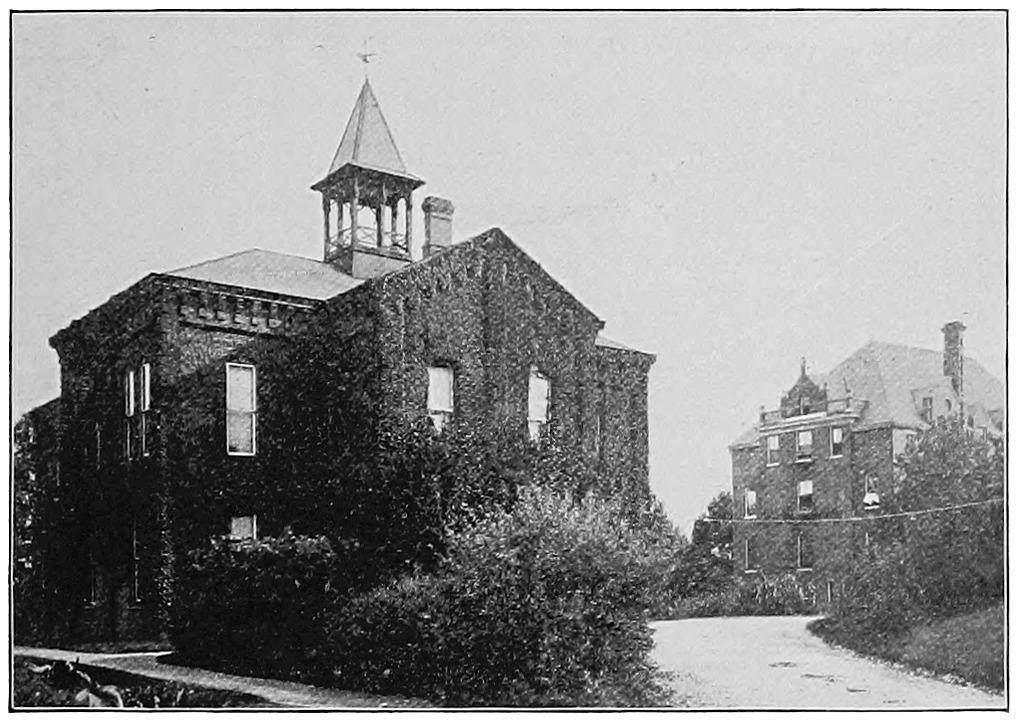
Around Knoxville are fine farms also, just as we find them about Harrisburg, Hagerstown, Winchester, and almost everywhere else in the Great Valley. Our view (Fig. 52) is taken near Knoxville and shows sloping fields always ready to bear good crops. The soils have been made by the wasting of the top parts of these same beds of marble and of other rocks found along with it.
In Knoxville, on the edge of the city, is the University of Tennessee, with many buildings upon its campus. It is an excellent school and an old one as well, having been founded in 1794. It was first named Blount College, from one of the prominent public men of the valley at that time, and is now one of the foremost schools of the South.
Only seven years before that date two old Revolutionary soldiers rode through the woods and picked out these lands, which were
F��. 67. O� ��� C����� �� ��� U��������� �� T��������given to them as a reward for their service in the war Here they built as a defense against the savages a wooden fort, with log cabins at the corners and a stockade with a stout barred gate. Such a fort was greatly needed in those days whenever a new settlement was made. After the two soldiers had planted corn they went back to North Carolina to bring their families over the mountains. This was the beginning of Knoxville, which grew up around the fort and soon spread over the hills and down to the river. The settlement was named in honor of Henry Knox, who was an able general in the Revolution and a good friend of George Washington.
Now the railroads reach out in every direction. They bring in the iron ore and the limestones of the valley. They also run up into the Cumberland Gap, and to Harriman, Tennessee, and bring back stores of coal, thus making Knoxville a place for working iron. To the east the Southern Railroad leads up the French Broad (Fig. 61) through deep gorges into the heart of the Great Smokies at Asheville, and across the Blue Ridge to the lowlands of North Carolina.
All this is very different from the samp mortars and the puncheon floors of early times, but the pioneers had a keen eye for the soil and the waters and the trees, and it is these which have helped to make the valley rich to-day.
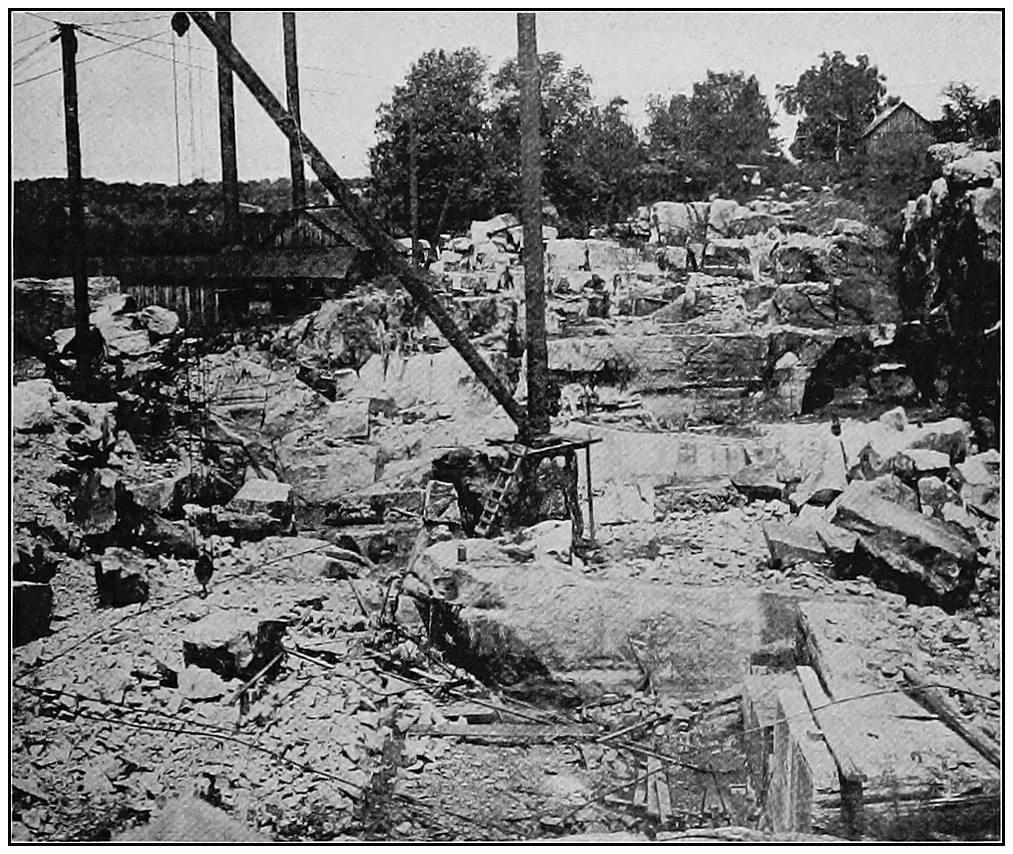
F��. 68. M����� Q����� ���� K��������
We must not forget that off to the west James Robertson had founded a city that is even older than Knoxville. In the great bend of the Cumberland, on its south bank, in northern Tennessee, stands Nashville, as we have already seen.
If we visit a large city in one of the countries of Europe, we are quite likely to be told, or to read in our guidebook, that its history goes back hundreds of years, and any town that was started only a hundred years ago would there seem young. But we measure age differently in America, and a town like Nashville, founded in 1780, we think is old indeed. It is not easy to remember, as we ride along the streets and see the shops and mansions of Nashville to-day, that this was once a place of log cabins, and that the first settlers had to sleep always with one ear open for the Indian’s war cry
That James Robertson had to learn to read from his wife did not keep Nashville from becoming one of the centers of education and refinement in the South. It would take several lines to record the names of all the colleges and universities that now have their seat in this city. Robertson was the sort of man who, with the opportunities of to-day, might have been the president of one of these schools, or he might perhaps have gained a fortune with which to help in their support. Farther west, on the Mississippi river, stands Memphis, a city still larger than Nashville; indeed, few southern states can boast of so many cities as Tennessee possesses. Besides these, there are fertile valleys, fine rivers and mountains, productive forests, beds of iron ore and coal, comfortable farms, and thriving towns. The state is rich, too, in historical associations. Every part of Tennessee saw the dark days of the Civil War, and in the fields south of Nashville a great battle was fought.
When John Sevier went down the Tennessee river on his Indian raids he noticed that the stream, making a great bend, turns away from the valley and flows by a deep gorge through the highlands of the Cumberland plateau. We can take the train now at Knoxville, and a ride of a little more than a hundred miles will bring us to this place.
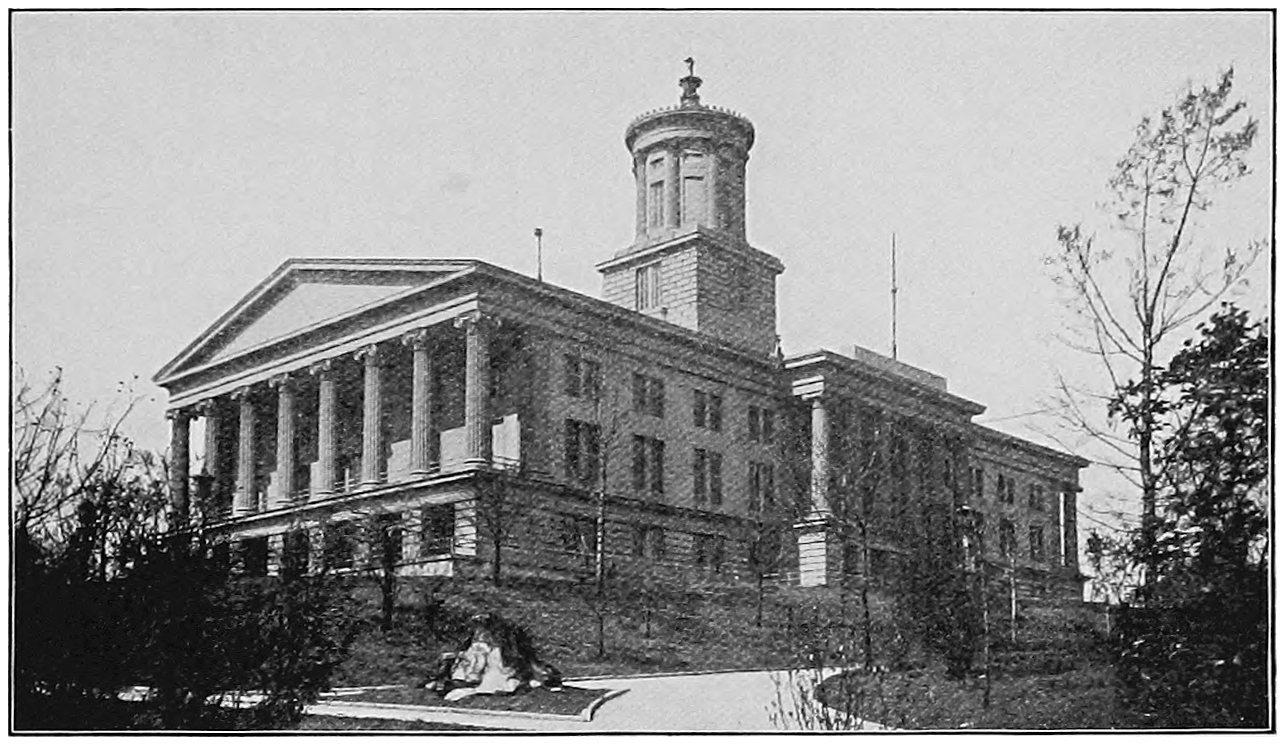 F��. 69. S���� H����, N��������
F��. 69. S���� H����, N��������
By the river is a steep, high ground known as Cameron hill. Let us go up to the top and look around. Stretching away at our feet on the east is Chattanooga. Part of the city as we see it from Cameron hill is shown in the picture (Fig. 70). Beyond is the Tennessee, and we are looking up the river to the northeast. The bridge which we see is the only bridge across the river at Chattanooga, even though it is now a large and busy city. In the distance is high ground, a part of Missionary Ridge, famous in the story of the Civil War.
If we turn around and look southward, we shall see Lookout Mountain, rising fifteen hundred feet above the river. A battle was fought on the steep slopes of this mountain also; and a few miles to the southeast is Chickamauga, one of the bloodiest battle grounds of the war. On the edge of the city, kept with care, is the National Cemetery, where rest the bodies of more than twelve thousand soldiers, northern and southern, who perished in the neighborhood of Chattanooga. Now all the region is peaceful, and only the tablets of iron and bronze, set up by the government on every battlefield in the neighborhood, tell the story of the conflict as it raged about the city.
Like Knoxville, Chattanooga has much coal and iron, is the center of a number of railways, and does much business. The railways run up the valley to Virginia, and south to Atlanta and elsewhere in Georgia. They stretch even further southward to Mobile and New Orleans, while the lines to the west reach Memphis and Nashville. Chattanooga is sometimes called the “Gate City” because it stands near the opening of the Great Valley into the wide plains along the gulf of Mexico. The place, originally called Ross’s Landing, was not settled until 1836, when Knoxville and Nashville were about fifty years old. It has a noble site and may well become a great city.
Here passed the boats that bore the first settlers to Robertson’s colony on the Cumberland. There are no Indians now to shoot from the banks, and you will see on the river only rafts of logs floating down from the forests in the mountains.

F��. 70. C����������, ������� N�������� ���� C������ H���. M��������� R���� �� ��� D�������
Atlanta also is often called the “Gate City” of the South. It stands more than a thousand feet above the sea, in northern Georgia, where the Appalachian mountain range is tapering down toward the southern plains. Because Atlanta is so high it is cooler in summer than most southern cities, and is always free from the scourge of yellow fever and cholera.
It is a natural site for a city, for here at the end of the great mountain system the long lines of railway that follow the Atlantic coast swing around to the west, passing on to the Mississippi and down to Mobile and the ports on the gulf of Mexico. Other railways reach Atlanta from Chattanooga and Knoxville in the Great Valley, and still others lead the way to Savannah and the Atlantic coast. Thus twelve lines of railway reach out from Atlanta like the spokes of a wheel and connect the city with all parts of the South. Let us take a map of the United States and draw a line through Richmond, Louisville, Nashville, and New Orleans. Notice how many states lie southeast of this line, and remember that of all the towns which they contain Atlanta is the largest and most important. Indeed, in trade
and influence it surpasses many northern cities which are much larger.
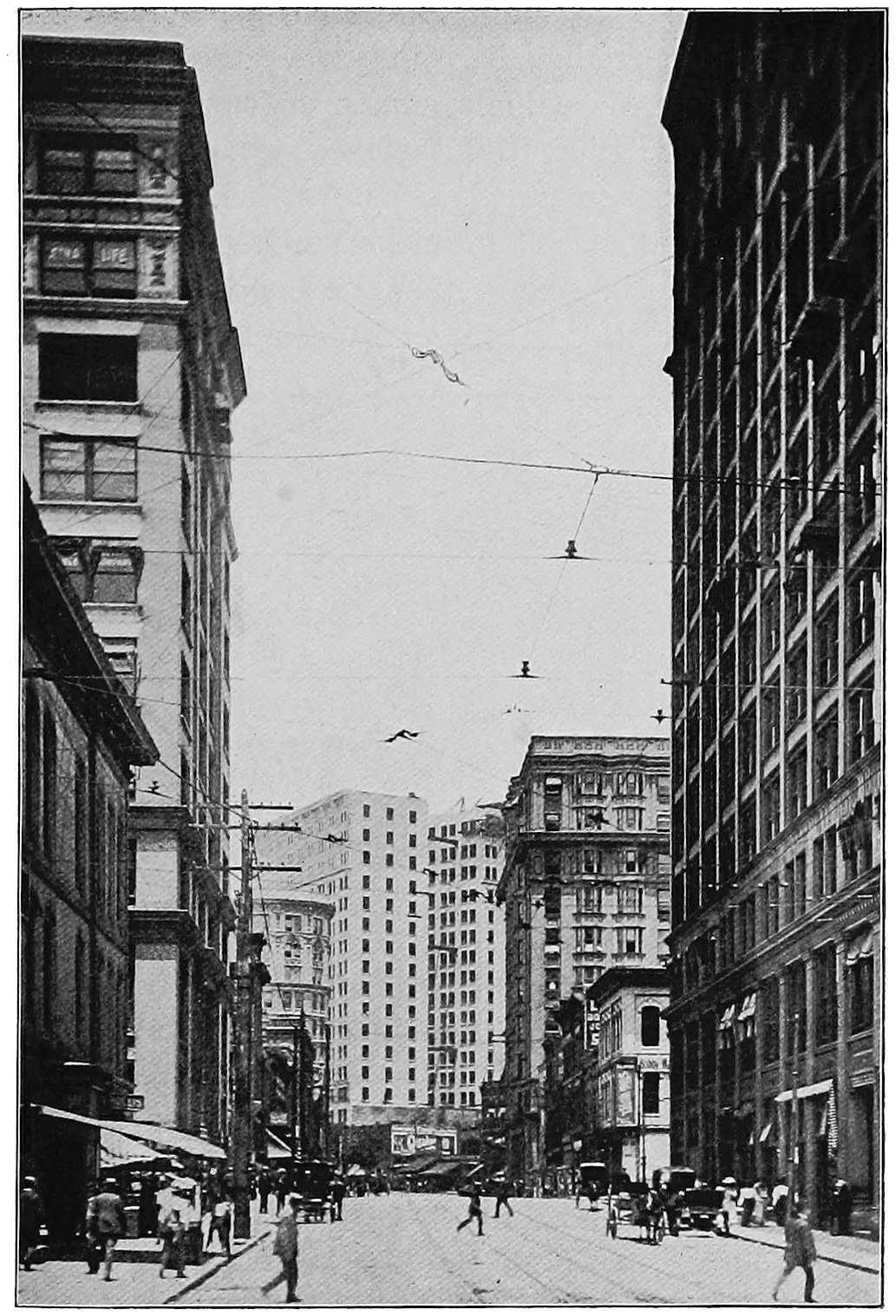 F��. 71. A������: B���� S�����, ������� N����
F��. 71. A������: B���� S�����, ������� N����
Atlanta saw stirring times in the Civil War It was small then, having but about ten thousand people. In 1864 most of it was burned to the ground, and we may truly say that it has grown to its present size in the short period since that time. To-day its population numbers more than one hundred thousand. During the recent Spanish War the Department of the Gulf made its headquarters here, so that Atlanta appears to be sought both in war and in peace. The city was used as the capital of Georgia soon after the Civil War, and in 1877 the people of the state voted that it should always be the seat of government. Since that time they have erected a capitol costing a million dollars, adorning the interior with marbles from their own quarries.
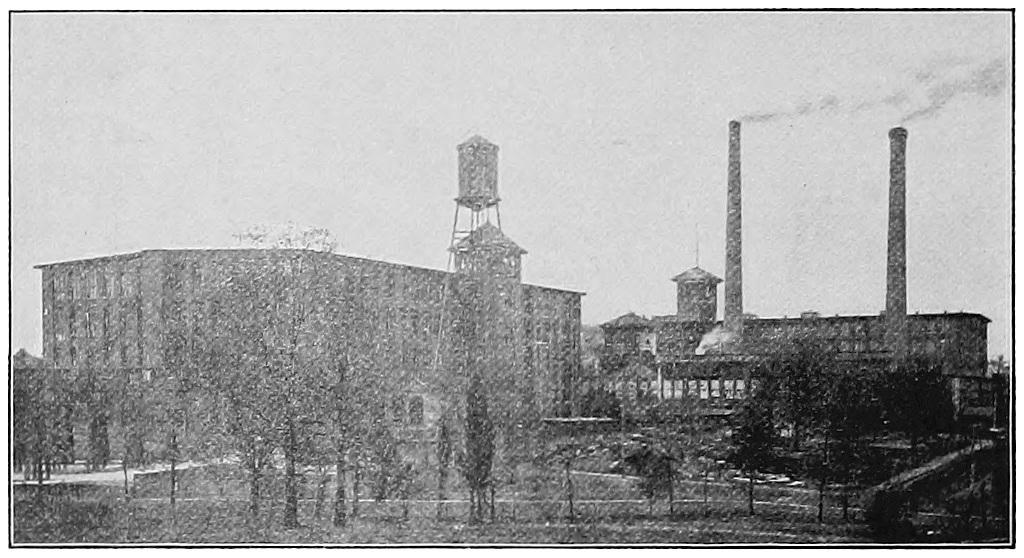
A few years ago an exposition was held at Atlanta to show the world the achievements and hopes of the great South. Everybody knew that the South raised cotton, but Atlanta wished to prove that the South could also spin and weave her famous product. Mr. W. G. Atkinson was the governor of Georgia at that time. During the exposition a day was chosen in which something unusual should be done. Men went out into a field in the morning and picked some cotton. It was ginned and spun and woven in double-quick time. Then tailors took some of the cloth, cut it, fitted it, and sewed it into a
F��. 72. F����� B�� ��� C����� M����, A������suit of clothes Governor Atkinson put on the suit and visited the grounds of the exposition. In the morning the cotton was in the field, in the evening it was on the governor. Suits are not made so quickly as that on ordinary days, but the South spins and weaves millions of dollars’ worth of cotton, turning the mill wheels with southern coal or with the waters of swift southern streams.

Atlanta is not only at the southern end of the mountains, but it is on the divide which separates the streams of the gulf from those of the Atlantic. On the one hand, not far away, is the Ocmulgee, flowing to the ocean, while westward, and distant but a few miles, the Chattahoochee flows toward the gulf. The latter river has been harnessed by man, and eleven thousand horse power measures the amount of energy that can be carried over the wires to Atlanta to move its cars and turn the wheels of its factories. The mills not only spin the cotton of the gulf plains but also turn out fertilizers, work up the timber of the region, and make a multitude of other things to swell the city’s trade with her neighbors.
F��. 73. G������ I�������� �� T���������, A������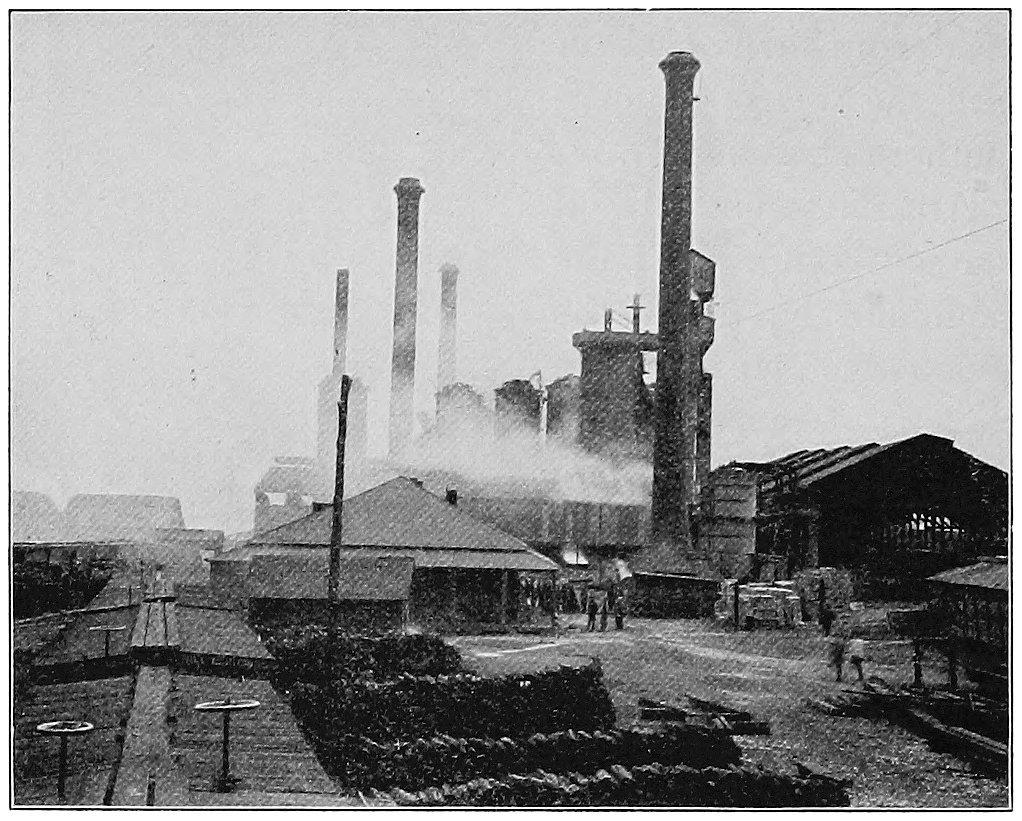
Appropriate to her needs, Atlanta has had since 1887 a school of technology, in which she teaches her sons how to develop the great resources of the South. Here are shops and departments of engineering, and, not least, instruction in making textiles, so that the cotton of southern fields need no longer go to Massachusetts or to England to be spun and woven.
The youngest great town of the southern mountain region was started on an old cotton plantation in 1871, thirty-four years before the writing of these lines. The people knew that in Alabama as well as in Tennessee coal and iron are found close together. So men built an iron town and called it, after one of the greatest furnace towns in the world, Birmingham. It is a noisy, busy place, with wide streets, swift electric cars, and blazing furnaces. To see it grow is like watching a new Pittsburg rise up in the heart of the South.
F��. 74. I��� F������, B���������From the Berkshire country at the north to the southern end of the Appalachians, there are to-day thriving towns and fertile fields. No longer does the mountain wall cut off the products of the West from the markets of the East. Yet hardly a hundred years ago the eastern strip of country was practically shut off from the whole territory drained by the Ohio and Mississippi rivers. Indian trails and rough roads were the only means of communication between the two sections. Great as are the natural resources of both regions, their prosperity has been bound up in the development of roads and railways, and is due in large measure to the energy, foresight, and self-sacrifice of those who crossed the barrier and made it easy for others to follow them.
INDEX
Adams, Charles Francis, cited, 7
Adams, John Quincy, 100
Adirondacks, 32
Albany, N.Y., 6, 10, 15, 16
Alexander, Mt., 130
Alexandria, Va., 41, 86
Allegheny Front, 74, 78, 80, 82
Allegheny Portage Railway, 75, 76, 80
Allegheny river, 111
Allentown, Pa., 79
Altoona, Pa., 77; description of, 81
Amsterdam, N.Y., 20
Ann, Fort, 32
Annapolis, Md., 88
Antietam, 132
Appalachians, southern, 174
“Arks” on the Susquehanna, 41
Arnold, Benedict, 37
Atkinson, Gov. W. G., 178
Atlanta, Ga., 174–180
Auburn, N.Y., 57
Bald Eagle valley, 80
Baltimore, Md., 53, 86, 101; growth of, 107
Baltimore and Ohio Railroad, 99, 101, 102, 110
Barges on the Ohio, 116, 118
Barton, Clara, cited, 82
Bay Road, Mass., 4
Bedford, Pa., 71, 77
Bemis Heights, 38
Bennington, Vt., 38
Berkshires, 5; railway through, 9, 10
Bethlehem, Pa., 79
Binghamton, N.Y., 52
Birmingham, Ala., 181
Black Rock (Buffalo), 47
“Blackbeard,” 130
Blockhouse at Pittsburg, 112
Blount College, 170
Blue Grass country, 127, 151, 166
Blue mountain, 79
Blue Ridge mountains, 88, 130
Boone, Daniel, early life, 144; training, 145; portrait, 145; moves to North Carolina, 146; serves with Braddock, 146; camps in Kentucky, 147; visits Cumberland Gap, 148; founds Boonesborough, 148; buys lands of the Indians, 149; marks out the Wilderness road, 149
Boonesborough, 148
Boston, Mass., 1, 2, 7, 12
Braddock, General, 69, 90, 91, 146
Braddock, Pa., 83
Brant, Joseph, 33
Bristol, Tenn., 134
British, in New York, 32; in the Ohio country, 156
Brownsville, Pa., 93, 117
Buffalo, 52, 57, 60, 110; growth of, 61
Burgoyne, General, 32, 37
Burnside, General, 168
Business, increase of, 114, 118
Cambria Steel Company, 83
Cameron hill, 173
Campbell, William and Arthur, 160
Canajoharie, N.Y., 24
Canals, 44; Erie, 7, 46, 48, 50–52; Pennsylvania, 74; Chesapeake and Ohio, 98–101, 107; Delaware and Hudson, 53; at Louisville, Ky., 127
Carlisle, Pa., 71, 79, 132
Carroll, Charles, 101
Carry to Schenectady, the, 19, 22
Catch-me-if-you-can, 2
Catskill mountains, 15, 32
Chambersburg, Pa., 71, 132
Champlain, lake, 31, 37
Charlottesville, Va., 142
Chattahoochee river, 179
Chattanooga, Tenn., 135; description of, 173–175
Cherokee Indians, 139, 149
Chesapeake bay, 86
Chesapeake and Ohio canal, 107; building of, 98–101
Chicago, 110
Chickamauga, 174
Chissel, Fort, 135
Cincinnati, Ohio, description of, 123–127
Clark, George Rogers, raises an army, 156; portrait, 157; captures Kaskaskia and Vincennes, 158
Clay, Henry, stories of, 96, 114
Cleveland, Benjamin, 160
Clinch river, 134
Clinton, De Witt, 44, 49; stirs up legislature, 40; portrait, 43; train, 53, 54
Coal, 104, 118, 122, 153, 170, 181
Cohoes, N.Y., 22
Coke ovens, 108
Columbia, The, 2
Columbia, Pa., 69, 74, 76
Columbus, Ohio, 94
Conemaugh river, 75, 82
Conestoga creek, 67
Conestoga Traction Company, 70
Conestoga wagons, 77
Connecticut river, 4
Construction, early railway, 105
Cooper, Peter, 106
Cornstalk, 155
Cornwallis, Lord, 158
Cotton, 178
Cumberland, Fort, 89, 90; city of, 93, 95, 102
Cumberland Gap, 142, 148, 150, 152
Cumberland mountains, 134, 142
Cumberland river, 164, 174
Cumberland road, 93
Cunard, Samuel, 2
Cunard line, 2, 8
Dams, use of, 119
Danforth, Mr., and salt making, 27
Deerfield valley, 8
Delaware and Hudson Canal Company, 53
Delaware, Lackawanna and Western Railroad, 60
De-o-wain-sta, 23
Detroit, 41, 156
Dickens, Charles, 126
Dinwiddie, Governor, 89
Doak, Rev. Samuel, 160
Dongan, Gov. Thomas, 40
Dunlap’s creek, 96
Dunmore, Lord, 155
Duquesne, Fort, 91
Dutch, in New York, 14, 18, 31
Earle, Mrs. Alice Morse, cited, 55
Easton, Pa., 79
Edward, Fort, 31
Emerson, Ralph Waldo, cited, 1
Empire State Express, 56
England, interest of, in fur trade, 18; railways of, 55
Erie canal, 7, 42, 46, 48, 50–52
Erie, lake, 18, 42, 98
Erie Railroad, 60
Euphrates river, 130
Fairfax, Lord William, 88
Falls of the Ohio, 127, 146, 152
Farms in Pennsylvania, 66
“Feeders” of Erie canal, 52
Ferguson, Patrick, 159
Finley, John, 146, 148
Fishing interests, 104
Flag, perhaps the first American, 34
Flatboats, 117
Floyd, Gen. William, 22
Forbes’s road, 71
Forts:
Orange, 17; Stanwix, 22, 23, 34, 37, 61, 149; Schuyler, 23; Johnson, 26; Edward, 31; Ann, 32; Ticonderoga, 32, 37, 38; Cumberland, 89, 90; Duquesne, 91; Chissel, 135; Sanders, 168
Franklin, Benjamin, 4, 69, 130
“Franklin,” state of, 166
Frederick, Md., 93
French, in Ohio country, 89
French and Indian War, 69
French Broad river, 135, 159, 170
Frostburg, Md., 90, 93
Fur trade, 18, 24, 40
Furnaces near Pittsburg, 121
Gansevoort, Col. Peter, 34
Gas, natural, 120
“Gate City,” the, 174
Genesee road, 24, 25
Genesee street, Utica, 23
Geneva, 24, 25
George, Mt., 130
Georgetown, D.C., 100
Georgia Institute of Technology, 179
Germans in Pennsylvania, 66; in Tennessee, 136
Ginseng, 24
Gist, Christopher, 89
Glass mills, 122
Gray, Captain, 2
Great Kanawha river, 155
Great Smoky mountains, 134, 170
Great Valley, the, 71, 130, 132, 134, 136, 139
Gulliver’s Travels, 150
Gypsum, 104
Hagerstown, Md., 25, 132, 165
Half Moon, the, 15
Halifax, 2
Hambright’s Hotel, 70
Hamburg-American line, 108
Hamilton, Col. Henry, 156
Hancock, Gov. John, 2
Hanks, Abraham, 149
Harlem, 14
Harpers Ferry, 107, 130, 132
Harriman, Tenn., 170
Harrisburg, Pa., 74, 85, 132; description of, 78
Henry, Patrick, 156
Herkimer, Nicholas, 29, 33, 35, 36
Hessians, 33, 38
Hill, Gen. A. P., 142
Hit or Miss, the, 77
Hiwassee river, 135
Hollidaysburg, Pa., 74
Holston river, 134
Honesdale, Pa., 53
Hoosac mountain, 5, 8
Hoosac tunnel, 9–11
Hoosick river, 5
Housatonic river, 5
Howe, General, 32
Hudson, Henry, 15, 16
Hudson river, 15
Huguenots, 136
Hulbert, cited, 105
Illinois, 158
Indiana, 158
Indians, 144, 149, 163, 164; in New York, 14, 17, 18, 33; at Watauga, 138; at Point Pleasant, 155
Indies, hope of reaching, 15
Iron works, 121, 129, 170, 180
Iroquois Indians, 18
Jackson, “Stonewall,” 133
James river, 133; gap, 134
Jefferson, Thomas, 156
Johns Hopkins University, 108
Johnson, Fort, 26
Johnson, John, 36
Johnson, Sir William, 20
Johnstown, N.Y., 20
Johnstown, Pa., 75, 76, 82
Joppa, 92
Juniata river, 74
Kaskaskia, Ill., 116, 157
Kentucky, 127, 154, 164; becomes a state, 165
Kings Mountain, 158, 160
Knights, Sarah, 4
Knox, Gen. Henry, 170
Knoxville, 134, 166, 170
Lake Shore Railroad, 110
Lancaster, Pa., 65, 72, 78
Lancaster pike, 65, 67, 70
Lee, Arthur, 113
Lee, Richard Henry, 98
Lee, Gen. Robert E., 132
Legislators allowed boat hire, 87
Lewis, Andrew, 155
Licking river, 124
Limestones, 104, 132, 151, 169
